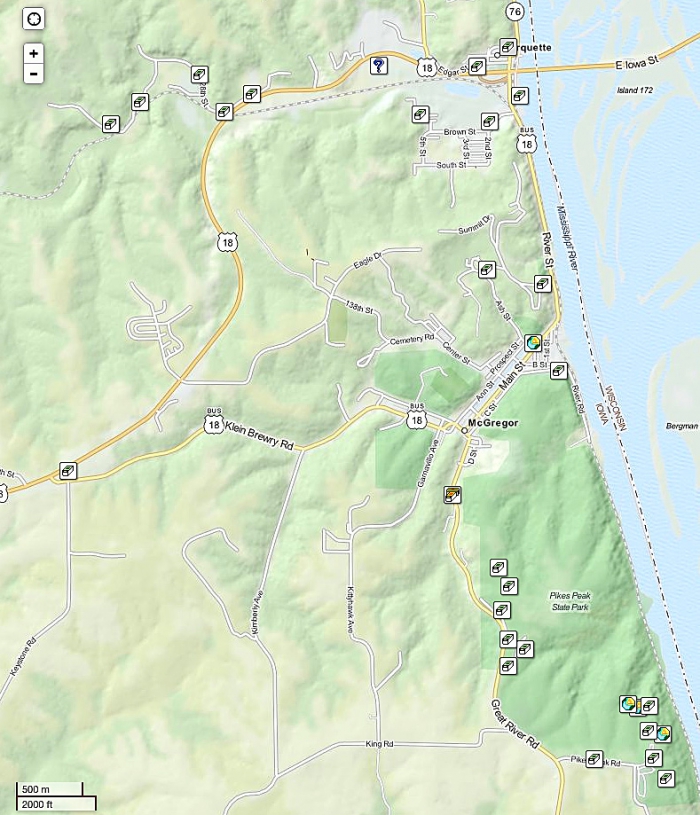Geocaching offers chance to explore area’s hidden treasures

The icons on this map from geocaching.com represent the geocaches located around the Mar-Mac area. Pikes Peak State Park (bottom right) and Bloody Run County Park (top left) are both popular locations.
By Audrey Posten, North Iowa Times Editor
The natural features, historic sites and cultural centers of the area offer an abundance of treasures for residents and visitors alike to enjoy, whether it’s a hike to the top of a bluff, a stay at a cozy B&B or a display of 100-plus-year-old items at a museum. But, sometimes, there’s more than meets the eye, as spots like these, as well as dozens of other local points of interest, are home to hidden treasures called geocaches (pronounced geo-cash).
Geocaching is an outdoor treasure hunting game. The term was coined from the words geography and cache, which refers to a hiding place for concealing and preserving items.
No map is needed to find the geocaches (or containers), just a set of GPS coordinates. Geocachers can use GPS devices or a GPS app on a smart phone to find their quarries.
“It’s an adventure, like finding a lost treasure,” explained Cynthia Torkelson, a seasonal naturalist with Clayton County Conservation, and also a geocacher herself.
Geocaches are plentiful in the area and located at a variety of spots. Pikes Peak State Park boasts over a dozen, hidden along trails or at an overlook. Bloody Run County Park is also home to a handful. In Marquette, the Depot Museum and Information Center, Driftless Area Wetlands Centre, a B&B and even a light pole offer treasures for the finding. The McGregor Heights has a geocache, as does the Ringling Brothers home, a 1960s-era bomb shelter in Farmersburg and the Sherman Swift Tower in National. Froelich and Monona each include several as well.
In order to receive coordinates for local geocaches, or any of the nearly 3 million others hidden around the world, visit the website geocaching.com. After setting up a free user name and password, simply type in the zip code of the area in which you would like to look. The site will generate geocaches within 10 miles of that area, displaying the results in a list form or allowing you to look at a map. By clicking on a geocache name, the geocacher can not only learn the coordinates, but also a description of the geocache and a difficulty rating. Fellow geocachers also log if they found the treasure, providing feedback and a story about their hunt.
The hiding spot of a geocache often reflects a place of importance or special interest to the geochacher who placed it.
The geocache containers come in a range of shapes and sizes—everything from a film canister or pill bottle to old peanut butter jars, large plastic containers or even fake rocks with hidden compartments. Each contains a logbook, on which those who locate the geocache are asked to record their find. Some even contain items, often of personal significance to the creator. Those who find the geocache are allowed to take an item as long as he or she replaces it with an item of equal or greater value.
There are different types of geocaches, with most listed as “traditional,” meaning it’s a simple container with a logbook and possibly a trade item. A “multi-cache” includes several locations (leading geocachers from one to the next), with the final one holding the physical container. An “earth cache” highlights special geological locations people can visit to learn about a unique feature of the Earth. Several of these are located within Pikes Peak. Another geocache is a “mystery or puzzle cache,” which asks geocachers to solve a puzzle in order to determine the correct coordinates. One of these brain teasers is located at the Wetlands Centre in Marquette.
“Ours is quite tricky and clever,” said Wetlands Centre Director Katrina Moyna, who noted that the geocache is a recent one, placed only several weeks ago. “It’s a huge surprise for them when they find it.”
The success of finding a geocache is quite a rush, added Torkelson.
“I like it when I find it because it can be hard,” she said. “The GPS only takes you so far, so sometimes there’s an extra 15 feet where you have to figure out where it is.”
Torkelson said she also enjoys checking out the geocache logs, seeing who’s been there before her.
Geocaching offers a great bonding experience with friends and family, added Moyna, as well as the chance to learn about new spots.
“It’s a great reason to travel and see different areas,” she noted. “You’re not only looking for clues, but you’re exploring.”
Some geocaches listed on the website include a comprehensive history of the area or the location, giving hunters an educational experience with their adventure. Many geocachers choose to peruse the community, park, museum or other spots where the geocache was hidden.
“You can have a little adventure in the county parks,” Torkelson said. Just don’t place your own geocache without permission. “People can put their own out, but they’re supposed to stop in [Osborne] and tell us.”
Torkelson said geocachers who would like to place a cache are asked to submit owner’s information about the geocache along with the type of geocache and container.
Asking for permission and following guidelines is a helpful rule to follow for placing any geocache. More information about hiding a geocache is available at geocaching.com.




